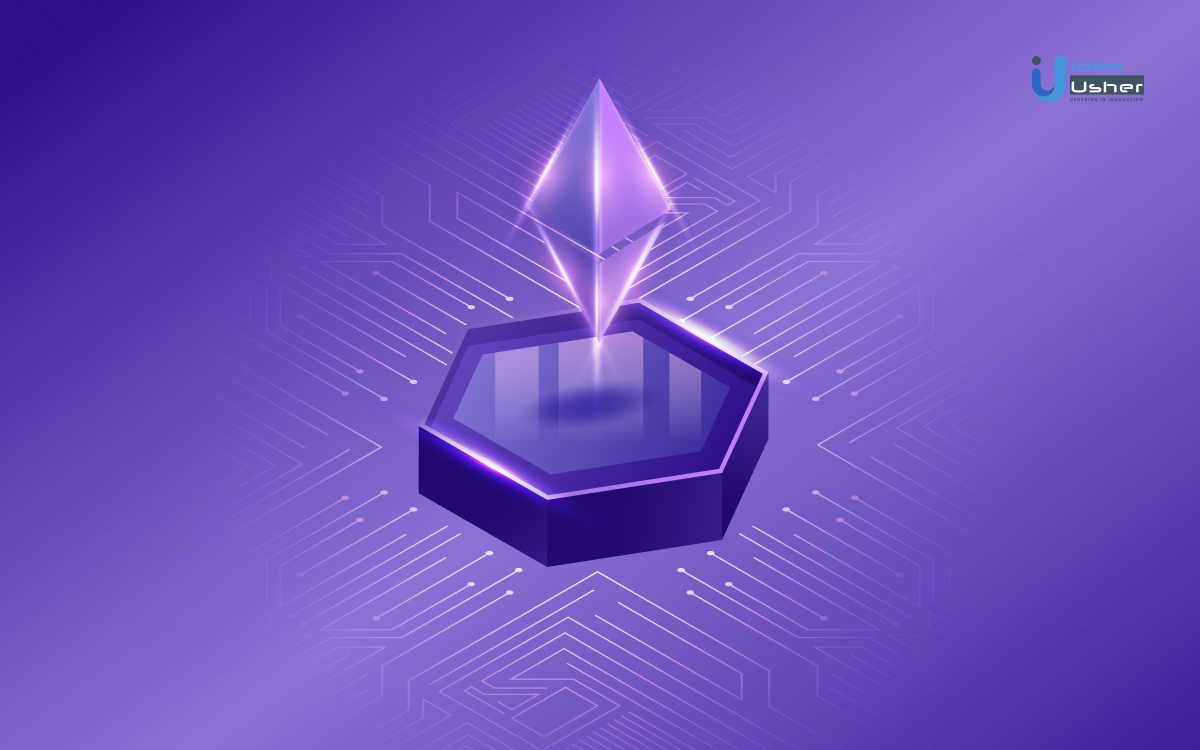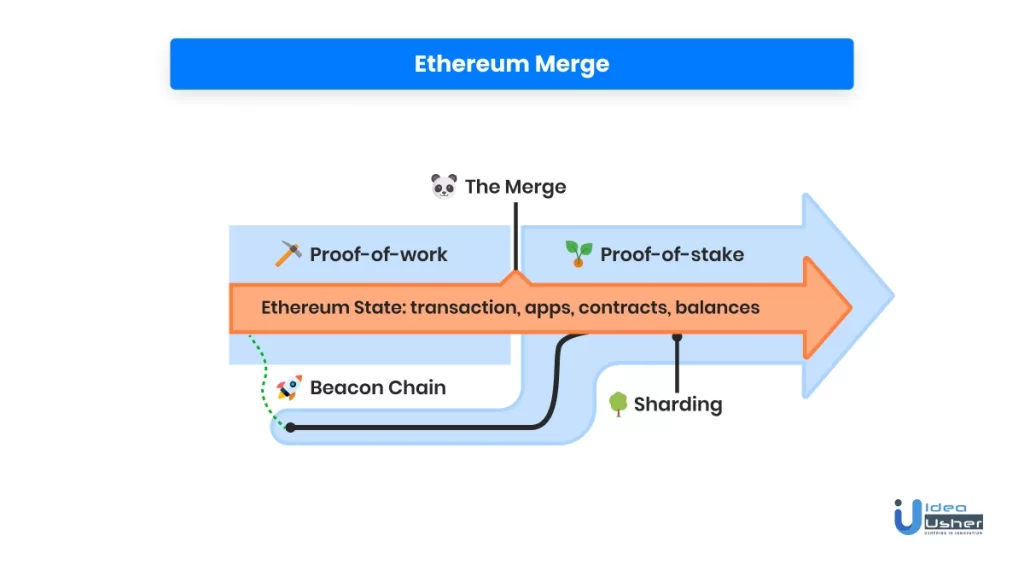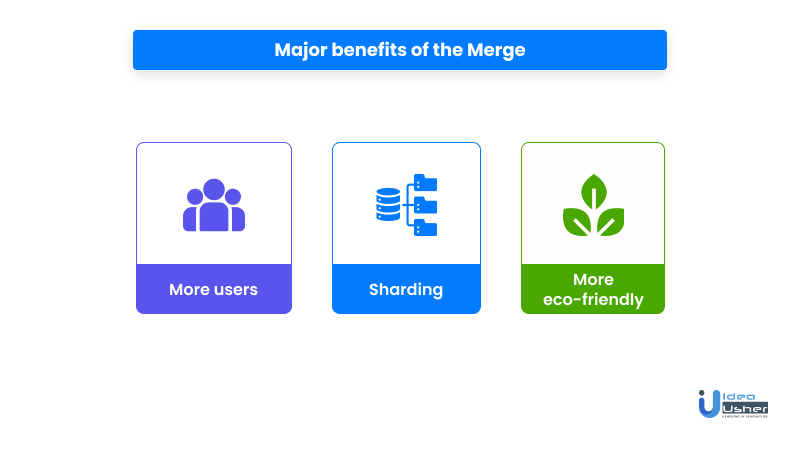- Critical crypto updates after the Ethereum Merge
- What is the Ethereum Merge?
- How did the Merge happen?
- What are the major benefits of the Merge?
- Misconceptions about Ethereum Merge
- The impact of the Merge on businesses
- What are some other things to know about the Merge and its impact on the crypto world?
- What do experts feel about Ethereum Merge and its future adoption?
- What are the other planned upgrades for Ethereum?
- Winding up
- Frequently asked questions

15th September 2022: A date worth remembering. Why?
Because the crypto world witnessed a historic transition—the transition of Ethereum from the proof-of-work (PoW) consensus algorithm to the proof-of-stake (PoS) system. Known as the Ethereum Merge, the event changed how transactions are validated on the Ethereum network.
But what exactly is Ethereum Merge? What impact has it had on the crypto world so far? How will it affect businesses in the long term?
This blog aims to answer these questions by deep-diving into the details of the Merge.
- Critical crypto updates after the Ethereum Merge
- What is the Ethereum Merge?
- How did the Merge happen?
- What are the major benefits of the Merge?
- Misconceptions about Ethereum Merge
- The impact of the Merge on businesses
- What are some other things to know about the Merge and its impact on the crypto world?
- What do experts feel about Ethereum Merge and its future adoption?
- What are the other planned upgrades for Ethereum?
- Winding up
- Frequently asked questions
Critical crypto updates after the Ethereum Merge
Three major things formed the headlines after the Merge:
- ETH’s price fell significantly after the Merge. Five days before the Merge, it approached $1,800, while on 20th September, it sank below $1,300.
- Several blockchains saw their contributed hash power (and consequently energy usage) surge in the run-up to the Merge and then plummet.
- While Ethereum corrected its market capitalization by over 8% in 24 hours, Bitcoin lost over 1%, and other cryptos like Binance Coin and Polygon lost about 0.7% and 2.3%.
What is the Ethereum Merge?

The Merge is the union between Ethereum’s initial execution layer (the Mainnet, which has existed since its inception) with its new PoS consensus layer, the Beacon Chain. It did away with the requirement for energy-intensive mining and instead allowed the network to be secured using staked ETH.
Initially, the Beacon Chain was distributed independently of Mainnet. The Ethereum Mainnet, with all of its accounts, balances, smart contracts, and blockchain data, remained proof-of-work protected, even as the Beacon Chain functioned in parallel using proof-of-stake. When these two systems finally combined in the Merge, proof-of-work was permanently replaced by proof-of-stake.
In the PoW algorithm, the network members compete by solving complex problems for the chance to be the ones chosen to add their copies of transactions to the ledger. In the PoS system, the members put up their crypto assets as collateral for the chance to have their record of transactions made official.
How did the Merge happen?
The Merge took place in two stages: the Bellatrix upgrade and the Paris upgrade. Ethereum officially got into ‘The Merge’ with the Bellatrix upgrade on 6th September 2022.
- Bellatrix was a network upgrade on the consensus layer. It is a crucial update as it consolidated the proof-of-stake chain with the execution layer and was the last before the Paris upgrade.
- The Paris upgrade marked the end of the Ethereum blockchain mining and signaled the switch from the PoW to the PoS consensus algorithm. It was activated when a certain level of Terminal Total Difficulty (TTD) was reached. As a result, when the PoW chain reached a specific amount of TTD, the PoW clients stopped processing the chain, and the PoW chain halted.
The execution layer then entered the picture on the PoS side, producing the block on top of the terminal PoW block, which was the first PoS block. So, the Paris upgrade was activated on the first PoS block on the Ethereum network.
What are the major benefits of the Merge?
The Merge predominantly displays three benefits that are likely to help the Ethereum ecosystem grow and improve in the future.

1. More eco-friendly
Earlier, Ethereum worked on the PoW mechanism, which required the network members to compete to validate the transactions on the network. The participants needed to solve complex problems to get the chance to validate the transaction. This process required massive amounts of computational power and investment in expensive machinery. Thus, the process was both energy-consuming and time-consuming.
The PoS mechanism does not need high power and expensive computers, thus eliminating the need for specialized hardware and cutting out electrical waste. According to Ethereum’s official website, the transition from PoW to PoS will lead to around a 99.95% reduction in Ethereum’s energy consumption. That’s not it! The transition will also lead to a global decrease in electricity consumption.
2. Sharding
Ethereum is still a blockchain under development.
Yes, you read that right. Vitalik Buterin, the co-founder of Ethereum, said that after the Merge, he views Ethereum as being only 55% complete.
So what else needs to be done? For Ethereum to reach its full potential, it needs to reduce its fees and increase the transaction speed. The Merge doesn’t solve these issues directly but lays the foundation for the network to increase its capacity and eventually become faster and inexpensive. It will achieve this through a process called sharding.
Sharding will divide Ethereum’s blockchain into smaller blockchains. Then, the validators do not have to validate all the transactions on the main blockchain; instead, they can focus only on the transactions within their shard. Sharding will also lighten the data storage requirements, thus incentivizing members to become validators.
3. More users
The Merge is a positive sign for many Ethereum participants as more of them will now be able to earn rewards for participating in and securing the network. By switching from PoW to PoS, miners will no longer validate the transactions.
Instead, the transactions will be processed via staking wherein the participants can commit a portion of their Ethereum holding toward validating transactions to earn a portion of transaction fees. While mining requires a significant initial investment and effort, staking is more accessible to regular Ethereum users.
Misconceptions about Ethereum Merge
It is normal to witness misconceptions surrounding new developments in the tech world. Here are a few misconceptions about the Merge and its justification.
| Misconception | Fact |
| Running a node on Ethereum requires staking 32 ETH. | Only validator nodes require staking a portion of Ethereum holding. Other nodes can run without committing any ETH. |
| The Merge failed to reduce gas fees. | The Merge was never intended to reduce gas fees. It was a change of consensus mechanism, not an expansion of network capacity. |
| The transaction speed increased substantially after the Merge. | There were minor changes in the speed, but it largely remained the same on Layer 1 as before the Merge. |
| The Merge allowed staking withdrawals. | Staked ETH and staking rewards cannot be withdrawn, and they continue to remain locked. The upcoming Shanghai upgrade will enable the withdrawals. |
The impact of the Merge on businesses
Before the Merge, many experts predicted that it will likely increase enterprise adoption. Paul Brody, global blockchain leader at EY, said that while the Merge will not affect most current enterprise use cases, it will transform how businesses perceive Ethereum.
Scalability
With its benefits, the Merge will eventually lead to more scalability and privacy for enterprises. As a result, it will be possible to address enterprise process needs more comprehensively in the future. However, a thing to note here is that the Merge does not directly improve the scalability. It paves the way for future upgrades that will address the scalability issue in the coming years.
Sustainability
In addition to scalability and privacy, the Merge will draw attention to the sustainability aspect of Ethereum. As energy consumption goes down by more than 99%, Ethereum becomes more sustainable than before.
Earlier, many large organizations with environmental, social, and governance goals shied away from building solutions on Ethereum because of its reputation for being environmentally unsustainable. However, with the Merge making Ethereum more eco-friendly, the network’s business ecosystem is likely to leap ahead.
It is too soon to judge the business impact of the Merge with certainty. The coming months might give a clearer vision of the enterprise adoption of Ethereum.
What are some other things to know about the Merge and its impact on the crypto world?
Bitcoin still uses PoW
Ethereum, the second largest cryptocurrency by market capitalization, has switched to a more eco-friendly algorithm—the PoS. But, the market leader, Bitcoin, still uses the PoW consensus mechanism to validate transactions.
Although the Merge might pressurize Bitcoin and other blockchains to make similar changes, they are likely to face resistance. Many Bitcoin advocates believe that PoW is more secure and decentralized than PoS and that switching over would jeopardize the blockchain’s core principles.
Because Bitcoin has by far the largest market capitalization of any cryptocurrency, its dedication to proof-of-work will impede any significant progress on crypto energy use.
The transition might invite more regulation
Another issue is that the Merge may attract increased regulatory scrutiny. Using proof of stake may result in a blockchain’s tokens being categorized as securities, a label that many in the digital asset industry are striving to avoid due to the increased regulatory requirements and attention that comes with it.
What do experts feel about Ethereum Merge and its future adoption?
Mixed responses are coming from the experts in the crypto community about the mainstream adoption of Ethereum post Merge. While some have shown their support and hailed the Merge, others have a different point of view.
Changpeng “CZ” Zhao, founder and CEO of Binance, said, “It certainly helps, but mass adoption is achieved by many innovations together.”
Tyler Winklevoss, the co-founder and CEO of cryptocurrency exchange Gemini, said, “The merge is a big milestone and a big step towards Ethereum being able to fulfill its ultimate promise.”
However, Mark Cuban, the Dallas Mavericks owner, said, “It’s a non-event.” According to him, Ethereum’s value remains in its smart contract abilities. He said, “Smart contracts haven’t changed. They are the driving technology for ETH.”
What are the other planned upgrades for Ethereum?
After the Merge, Ethereum has planned a series of upgrades in multiple stages: the Surge, the Verge, the Purge, and the Splurge. Let’s discuss each of these stages in detail.
The Surge
Through the Surge, Ethereum will introduce systems to make the network more expandable or scalable via sharding and rollups.
Sharding
As stated earlier, sharding will split the Ethereum network into smaller pieces, known as ‘shards,’ increasing the network’s scalability. It will do so by breaking the data within the same blockchain, thus creating multiple mini-blockchains. It will then aim to create a physically sharded system of 64 linked databases. If sharding on Ethereum can be achieved, each user could save a portion of the update to the database rather than the entire thing.
Rollup
Rollups execute transactions outside Ethereum’s foundation layer (layer 1) and subsequently upload the transaction data to the layer 1 blockchain, allowing it to use the main Ethereum security chain.
Currently, there are two types of rollups:
- Optimistic rollups: They assume that transactions are valid for a default period and run on layer 2 networks before returning to the base layer.
- Zero-knowledge rollups: They run the transactions off-chain and submit the proof of validity to the layer 1 network.
The Verge
The Verge will also aim to tackle the scalability issue by introducing Verkle trees. According to Buterin, the Verkle trees are a “powerful upgrade to Merkle proofs that allow for much smaller proof sizes.” The Verge will optimize storage and shrink node sizes, ultimately making Ethereum more scalable.
Verkle trees will allow you to store a vast amount of data by displaying a short proof of any piece of that data, which will then be confirmed by someone with the tree’s root only. This method will make proofs considerably more efficient.
The Purge and the Splurge
The Purge aims at reducing spare historical data. By reducing the amount of historical data, validators can validate the blockchain more efficiently under the new proof-of-stake consensus mechanism. It should minimize network congestion and enable a more significant number of transactions to be completed on the blockchain.
The Splurge aims to ensure that the network continues to perform properly and the previous upgrades do not cause any issues.
Winding up
The Ethereum Merge was a long-awaited event for crypto enthusiasts. With it finally completed, a lot of changes have taken place in the crypto ecosystem. The prices have fallen, energy consumption has reduced, hash rates have seen fluctuations, and there are many speculations about the potential effects of the Merge.
However, one thing is certain—Ethereum’s transition from PoW to PoS is a significant move for both the network itself and the other blockchains. Ethereum isn’t stopping to upgrade its network with the Merge; several other upgrades are planned to be introduced in the future. It would be interesting to see how the Merge and the future upgrades will impact the crypto ecosystem and businesses in general.
Experts at Idea Usher, a leading technology company, regularly keep a tab on the updates and changes taking place in the world of blockchain and Web3. You can connect with us for more information about blockchain and how it can help you scale your business:
E-mail: [email protected]
Phone Numbers : (+91) 946 340 7140, (+91) 859 140 7140 and (+1) 732 962 4560
Frequently asked questions
Here are some exciting FAQs about Ethereum Merge:
1. Was ETH Merge successful?
Ethereum’s transition from PoW to PoS was successfully completed on 15th September 2022. However, its meaningful implications can be assessed only in the long term.
2. How long was Ethereum Merge?
The first part of the Merge, the Bellatrix upgrade, took place on 6th September 2022. However, the final part, the Paris upgrade, lasted for around 15 minutes on 15th September 2022 before it was declared a success.
3. Why is the Ethereum Merge important?
Ethereum Merge is important because of its significant impact on energy consumption, price, hash rate, and other components of the crypto ecosystem.









Shubham Gupta